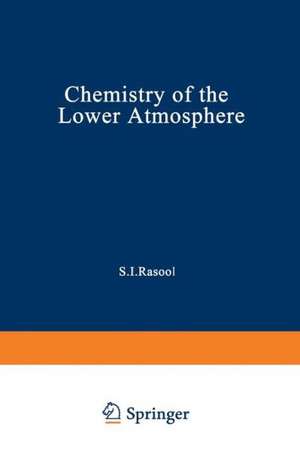Chemistry of the Lower Atmosphere
Autor S. Rasoolen Limba Engleză Paperback – 19 mar 2012
Preț: 642.36 lei
Preț vechi: 755.72 lei
-15% Nou
Puncte Express: 964
Preț estimativ în valută:
122.91€ • 128.68$ • 101.70£
122.91€ • 128.68$ • 101.70£
Carte tipărită la comandă
Livrare economică 05-19 aprilie
Preluare comenzi: 021 569.72.76
Specificații
ISBN-13: 9781468419887
ISBN-10: 1468419889
Pagini: 352
Ilustrații: XII, 335 p.
Dimensiuni: 152 x 229 x 18 mm
Greutate: 0.47 kg
Ediția:Softcover reprint of the original 1st ed. 1973
Editura: Springer Us
Colecția Springer
Locul publicării:New York, NY, United States
ISBN-10: 1468419889
Pagini: 352
Ilustrații: XII, 335 p.
Dimensiuni: 152 x 229 x 18 mm
Greutate: 0.47 kg
Ediția:Softcover reprint of the original 1st ed. 1973
Editura: Springer Us
Colecția Springer
Locul publicării:New York, NY, United States
Public țintă
ResearchCuprins
1 The Role of Natural and Anthropogenic Pollutants in Cloud and Precipitation Formation.- 1. Introduction.- 2. If There Were No Aerosols in the Atmosphere.- 3. The Role of Aerosols in Nucleating Cloud Drops.- 4. The Role of Aerosols in the Formation of Precipitation in Warm Clouds.- 5. The Role of Aerosols in Nucleating Ice Crystals.- 6. The Role of Aerosols in the Formation of Precipitation in Supercooled Clouds.- References.- 2 Particulate Matter in the Lower Atmosphere.- 1. Introduction.- 2. The Troposphere.- 3. The Lower Stratosphere.- References.- 3 Removal Processes of Gaseous and Particulate Pollutants.- 1. Introduction.- 2. The Physical Chemistry of Removal of Trace Gases.- 3. Removal Mechanisms for Aerosols.- 4. Summary and Conclusions.- Acknowledgment.- References.- 4 The Global Sulfur Cycle.- 1. Introduction.- 2. The Nature of the Sulfur Cycle.- 3. The Chemistry of Sulfur in the Global Environment.- 4. Concentrations of Sulfur.- 5. Contents of the Reservoirs.- 6. Transfer Mechanisms and Rates.- 7. The Global Sulfur Cycle.- 8. Discussion.- References.- Bibliography of Sulfur Cycles.- 5 The Chemical Basis for Climate Change.- 1. Introduction.- 2. Lessons to be Learned from the Past.- 3. Approach to a Theory of Climate: Interactions Among Atmospheric Chemistry, Radiation, Radiation, and Dynamics.- 4. Natural and Man-Made Influences on Atmospheric Composition.- Acknowledgment.- References.- 6 The Carbon Dioxide Cycle: Reservoir Models to Depict the Exchange of Atmospheric Carbon Dioxide with the Oceans and Land Plants.- Preface.- I. Formulation and Mathematical Solution of the Model Equations.- 1. Introduction.- 2. Three-Reservoir Atmosphere-Ocean Tandem Model.- 3. Four-Reservoir Tandem Model with Land Biota.- 4. Five-Reservoir Branched Model with Divided Land Biota.- II. Chemical Specification and Numerical Results.- Preface.- 5. Derivation of Transfer Coefficients for the Land Biota.- 6. Derivation of Transfer Coefficients for Air-Sea Exchange.- 7. Derivation of Transfer Coefficients for Exchange Within the Ocean.- 8. Observational Data.- 9. Numerical Results and Discussion.









